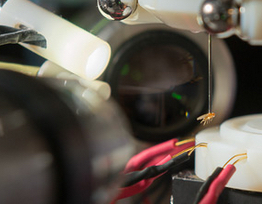Fly-catching robot speeds biomedical research
May 25, 2015

A fruit fly hangs unharmed at the end of the robot’s suction tube. The robot uses machine vision to inspect and analyze the captured fly. (credit: Stanforf Bio-X)
Stanford Bio-X scientists have created a robot that speeds and extends biomedical research with a common laboratory organism — fruit flies (Drosophila).
The robot can visually inspect awake flies and carry out behavioral experiments that were impossible with anesthetized flies. The work is described today (May 25) in the journal Nature Methods.
“Robotic technology offers a new prospect for automated experiments and enables fly researchers to do several things they couldn’t do previously,” said research team leader Mark Schnitzer, an associate professor of biology and of applied physics.
“For example, it can do studies with large numbers of flies inspected in very precise ways.” The group did one study of 1,000 flies in 10 hours, a task that would have taken much longer for even a highly skilled human.
Zap, you’re part of an experiment
When the robot’s fly-snatching apparatus is ready to grab a fly, it flashes a brief infrared blast of light that is invisible to the fly. The light reflects off its thorax, indicating the precise location of each fly and allowing the robot to recognize each individual fly by its reflection pattern. Then, a tiny, narrow suction tube strikes one of the illuminated thoraxes, painlessly sucking onto the fly and lifting it up.
Once the fly is attached, the robot uses machine vision to analyze the fly’s physical attributes, sort the flies by male and female, and even carry out a microdissection to reveal the fly’s minuscule brain. In one experiment, the robot’s machine vision was able to differentiate between two strains of flies so similar they are indistinguishable to the human eye.
Speeding disease research
All this is good news to the legion of graduate students who still spend hours a day looking at flies under a microscope as part of work that continues to uncover mechanisms in human aging, cancer, diabetes and a range of other diseases.
Although flies and humans have obvious differences, in many cases our cells and organs behave in similar ways and it is easier to study those processes in flies than in humans. The earliest information about how radiation causes gene mutations came from fruit flies, as did an understanding of our daily sleep/waking rhythms. And many of the molecules that are now famous for their roles in regulating how cells communicate were originally discovered by scientists hunched over microscopes staring at the unmoving bodies of anesthetized flies.
Now, that list of fruit fly contributions can be expended to include behavioral studies, previously impossible because the humans carrying out the analysis can neither see fly behaviors clearly nor distinguish between individuals.
In their paper, Schnitzer and his team had the robot pick up a fly and carry it to a trackball. Once there, they exposed the fly to different smells and could record how the fly behaved — racing along the trackball to get closer or attempting to turn away.
The work was funded by the W.M. Keck Foundation, the Stanford Bio-X program, an NIH Director’s Pioneer Award, and the Stanford-NIBIB Training Program in Biomedical Imaging Instrumentation.